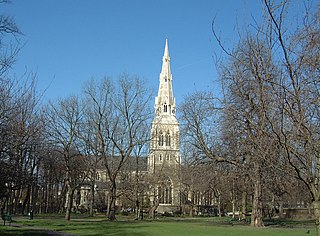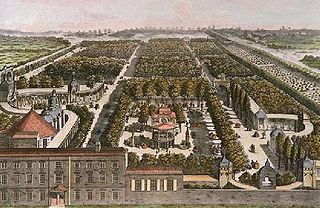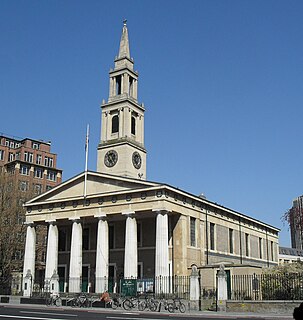Related Research Articles

Camberwell is a district of South London, England, in the London Borough of Southwark, 2+3⁄4 miles southeast of Charing Cross.

The London Borough of Southwark in south London forms part of Inner London and is connected by bridges across the River Thames to the City of London and London Borough of Tower Hamlets. It was created in 1965 when three smaller council areas amalgamated under the London Government Act 1963. All districts of the area are within the London postal district. It is governed by Southwark London Borough Council.

Kennington is a district in south London, England. It is mainly within the London Borough of Lambeth, running along the boundary with the London Borough of Southwark, a boundary which can be discerned from the early medieval period between the Lambeth and St George's parishes of those boroughs respectively. It is located 1.4 miles (2.3 km) south of Charing Cross in Inner London and is identified as a local centre in the London Plan. It was a royal manor in the parish of St Mary, Lambeth in the county of Surrey and was the administrative centre of the parish from 1853. Proximity to central London was key to the development of the area as a residential suburb and it was incorporated into the metropolitan area of London in 1855.

Newington is a district of South London, just south of the River Thames, and part of the London Borough of Southwark. It was an ancient parish and the site of the early administration of the county of Surrey. It was the location of the County of London Sessions House from 1917, in a building now occupied by the Inner London Crown Court.

Vauxhall is a district in southeast London, part of the London Borough of Lambeth, England. Vauxhall was part of Surrey until 1889 when the County of London was created. Named after a medieval manor, "Fox Hall", it became well known for the Vauxhall Pleasure Gardens.

Lambeth was a civil parish and metropolitan borough in south London, England. It was an ancient parish in the county of Surrey. The parish was included in the area of responsibility of the Metropolitan Board of Works in 1855 and became part of the County of London in 1889. The parish of Lambeth became a metropolitan borough in 1900, following the London Government Act 1899, with the parish vestry replaced by a borough council.

Burgess Park is a public park situated in Camberwell the London Borough of Southwark, and is close to Walworth to the north and Bermondsey to the east. At 56 hectares, it is one of the largest parks in South London.

Cremorne is a small inner suburb of Melbourne, 2 km south-east of the CBD. Its local government area is the City of Yarra and at the 2016 census it had a population of 2,018. It is bounded by the Yarra River, Punt Road, Swan and Church Streets, and divided down the middle by the railway to South Yarra. Covering only about a square kilometre, until 1999 Cremorne existed only as a locality in the larger suburb of Richmond. Cremorne's charm is in its rather chaotic mix of uses and the unique character resulting from being 'walled in' by main roads and railways on all sides. There are industrial icons such as Bryant and May and Rosella factories, and the Nylex Clock, side by side with Victorian cottages, modern townhouses, offices and light industries.

Nunhead is a suburb in the London Borough of Southwark in London, England. It is an inner-city suburb located 4 miles (6.4 km) southeast of Charing Cross. It is the location of the 52-acre (0.21 km2) Nunhead Cemetery. Nunhead has traditionally been a working-class area and, with the adjacent neighbourhoods, is currently going through a lengthy process of gentrification. Nunhead is the location of several underground reservoirs, built by the Southwark and Vauxhall Waterworks Company.

The Diocese of Southwark is one of the 42 dioceses of the Church of England, part of the worldwide Anglican Communion. The diocese forms part of the Province of Canterbury in England. It was created on 1 May 1905 from part of the ancient Diocese of Rochester that was served by a suffragan bishop of Southwark (1891–1905). Before 1877 the area was part of the Diocese of Winchester.

The Roman Catholic Archdiocese of Southwark is a Roman Catholic archdiocese of the Latin Rite in England. The archiepiscopal see is headed by the Archbishop of Southwark. The archdiocese is part of the Metropolitan Province of Southwark, which covers the South of England. The cathedral church is St George's Cathedral, Southwark.

Vauxhall Gardens is a public park in Kennington in the London Borough of Lambeth, England, on the south bank of the River Thames.

Ranelagh Gardens (; alternative spellings include Ranelegh and Ranleigh, the latter reflecting the English pronunciation, were public pleasure gardens located in Chelsea, then just outside London, England, in the 18th century.

Cremorne Gardens were popular pleasure gardens by the side of the River Thames in Chelsea, London. They lay between Chelsea Harbour and the end of the King's Road and flourished between 1845 and 1877; today only a vestige survives, on the river at the southern end of Cheyne Walk. Cremorne is also a ward of the Royal Borough of Kensington and Chelsea. The population of the ward at the 2011 Census was 7,974.

The A202 is a primary A road in London. It runs from New Cross Gate to London Victoria station. A section of the route forms a part of the London Inner Ring Road between Vauxhall and Victoria, known as Vauxhall Bridge Road.

Francis Octavius Bedford (1784–1858) was an English ecclesiastical architect, who designed four Greek Revival churches in south London during the 1820s. He later worked in the Gothic style.

St John's Church, Waterloo, is an Anglican Greek Revival church in South London, built in 1822–24 to the designs of Francis Octavius Bedford. It is dedicated to St John the Evangelist, and with St Andrew's, Short Street, forms a united benefice.
Thomas Davey was a British florist and nurseryman based in Camberwell, Surrey, and later in Chelsea, Middlesex, both now in London, England. The son of a nurseryman of the same name, he was known for his "florists' flowers", the type of flowers traditionally popular with English florists, and specialised in tulips, geraniums, and pinks. He capitalised on a new enthusiasm for tulips and flower-growing at the start of the 19th century in what has been described as a "cult of florists' flowers", giving exhibitions that attracted large crowds and publishing sales catalogues, one of which offered nearly 800 different types of tulip bulbs.

Our Lady and St Edmund's Church is a Roman Catholic parish church in Abingdon-on-Thames, Oxfordshire, England. It was built in 1857, designed by William Wardell and George Goldie and paid for by Sir George Bowyer, 7th Baronet in the Gothic Revival style. It is located on the corner of Radley Road and Oxford Road near the town centre.
References
- 1 2 3 4 ""Old and New London": Chapter XVI Camberwell". Archived from the original on 20 March 2022. Retrieved 2 June 2022.
- 1 2 3 4 5 "Gregson, Jonathan, "The lost gardens of Wyndham Road", Camberwell Quarterly, Winter 2016/7, 191.8" (PDF). Archived (PDF) from the original on 26 January 2022. Retrieved 2 June 2022.
- ↑ "Gregson, Jonathan, "The lost gardens of Wyndham Road", Camberwell Quarterly, Winter 2016/7, 191.9" (PDF). Archived (PDF) from the original on 26 January 2022. Retrieved 2 June 2022.
- ↑ "Clergy of the Church of England Database: The Rev Henry Woodcock Hyde". Archived from the original on 3 June 2022. Retrieved 2 June 2022.
- ↑ "Gregson, Jonathan, "The lost gardens of Wyndham Road", Camberwell Quarterly, Winter 2016/7, 191.11" (PDF). Archived (PDF) from the original on 26 January 2022. Retrieved 2 June 2022.
- ↑ "Jacobs v Mouflet", Globe , 21 December 1852, p 4.
- ↑ "The Bankruptcies of Vauxhall and Flora Gardens", The Era , 17 March 1850, p 12.
- ↑ "In Re T.P. Hemmings – The Flora Gardens", Bell's Weekly Messenger , 16 March 1850, p 7.
- 1 2 3 4 5 6 7 8 "Gregson, Jonathan, "The lost gardens of Wyndham Road", Camberwell Quarterly, Winter 2016/7, 191.12" (PDF). Archived (PDF) from the original on 26 January 2022. Retrieved 2 June 2022.
- ↑ "Wholesale Passing of Forged Notes", Lambeth and Southwark Advertiser, 7 June 1856, p 6.
- 1 2 "The Flora Gardens", The Era, 24 October 1858, p 7.
- ↑ "Advertisement", Morning Advertiser , 18 October 1864, p 8.
- ↑ "Advertisement", Sainsbury's Weekly Register and Advertising Journal, 1 November 1862, p 2.
- ↑ "Advertisement: Royal Flora Gardens", The Era, 7 September 1851, p 15.
- ↑ "Advertisement", Morning Advertiser, 15 May 1852, p 8.
- ↑ "A Gay Deceiver – Maidens, Beware of the Flora!", The Era, 18 August 1850, p 15.
- ↑ "Advertisement", Morning Advertiser, 22 May 1863, p 1.
- ↑ "Advertisement", Morning Advertiser, 16 August 1864, p 1.
- 1 2 "Pubology: Warrior". Archived from the original on 7 May 2017. Retrieved 3 June 2022.
- 1 2 Former places of worship in the Diocese of Southwark: Wyndham Road Mission, Camberwell, CAM19.
- ↑ Former places of worship in the Diocese of Southwark: St Michael & All Angels, Camberwell, CAM14.
- ↑ "Geograph: St Michael's & All Angels, Camberwell". Archived from the original on 18 August 2019. Retrieved 3 June 2022.
- ↑ "Geograph: New St Michael's Church, Camberwell". Archived from the original on 15 July 2018. Retrieved 3 June 2022.
- ↑ "Southwark News: "Two-storey school in Peckham gets go-ahead", 8 October 2015" . Retrieved 4 June 2022.
- ↑ "AHMM: ARK All Saints Academy" . Retrieved 4 June 2022.
- ↑ "Diocese of Southwark: St Michael & All Angels, Camberwell". Archived from the original on 17 May 2021. Retrieved 3 June 2022.
- ↑ "Wroth, Warwick, "Cremorne and the Later London Pleasure Gardens", p 79". Archived from the original on 25 June 2021. Retrieved 3 June 2022.